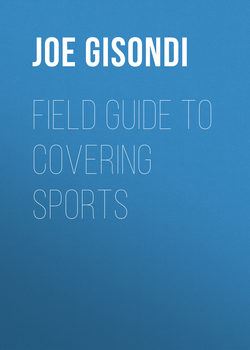Читать книгу Field Guide to Covering Sports - Joe Gisondi - Страница 37
На сайте Литреса книга снята с продажи.
Ask
ОглавлениеThis, of course, is the heart of the interview: asking good questions. Every question should have a purpose. Ask questions because you really want the answers, not just to get a quote or to hear yourself speak.
Often, the simplest question is the best, says Steve Goff, soccer beat reporter for The Washington Post. What was the difference in the final five minutes? What did you like about your team tonight?
Simple questions encourage clear, lucid answers, even on complex issues.
Digital Assist: Post Interviews
Host live chats with coaches and players in a location online, where readers can pose questions or follow along. Afterward, post the transcripts of these chats, as The Dallas Morning News does. Post headlines from stories and blog entries on Twitter, along with a link, to attract more readers. But you have to tweet regularly about breaking news or readers won’t stay signed up. Check out some examples at www.dallasnews.com/sports.
Here are some more suggestions for drawing out the best information from sources:
▸ Make questions specific. The open-ended questions Goff talks about are a good way to get someone talking. Then target later questions more precisely, to get exactly what you need. Did the quarterback see the lineman rushing in the play? Did the batter notice much movement on that last pitch? “Ask a straight question without beating around the bush,” says Ed Bouchette, NFL beat writer for the Pittsburgh Post-Gazette. “And do so in a way in which you actually get someone to think and answer, rather than saying yes or no.” Of course, you can ask yes-or-no questions but only when you are prepared to ask follow-up questions to acquire additional information.
▸ Ask athletes to summarize their performances. How did the course play? How would you describe the play of their offensive line? What were you thinking when you moved ahead 40 yards on the last lap? Did the opposing team exploit any specific weaknesses at any point during the match? You want your story to convey behind-the-scenes details, the stuff no one can get from sitting and watching.
▸ Encourage people to tell you stories. Ask about the minute details—sights, sounds, and scents as well as thoughts and feelings. Show that you’re interested in everything the interviewee can remember about key moments. Listen and record as much as possible, because you never know which details you’ll need later. Then write the story even more concisely by editing unnecessary words, details, and ideas.
▸ Avoid the ultimate cliché question: How did you feel about (winning, losing, getting hurt, whatever)? The golfer who sank the winning putt or the batter who drilled the game-winning hit is ecstatic. The running back who fumbled near the goal line in a loss feels miserable. No surprises there. Focus on questions that yield less obvious responses and information your audience doesn’t already know. You could ask a golfer at what point she realized the putt was going to fall into the hole or ask a tailback to explain and describe the moment the football started to fall loose from his arms for a fumble. These types of questions usually prompt athletes to focus on specific details instead of delivering a clichéd response.
▸ Keep questions neutral. Your job is to find out what someone thinks, not to persuade the person to agree with you or with some preformed idea of a story. Beware of questions that begin with Don’t you think . . . ? Most people want to be liked and will agree with you. What does anyone learn from that? The best questions produce answers that surprise you.
▸ Shut up and listen. You are not the focus of the story; nobody cares what you think. “Experts appreciate that you’ve done your homework and can ask intelligent questions, but they don’t want to hear you talk,” says Bruce Selcraig of Sports Illustrated. “Don’t try to impress them. Let them impress you.” Resist the temptation to display your expertise. “The worst habit I see in reporters is their need for analyzing the game and forcing a coach or an athlete to respond,” says Chuck Gormley, hockey beat reporter for the Courier-Post in Camden, New Jersey. “The role of the journalist is not to show an athlete or coach what he or she knows, but to elicit a response from that athlete or coach.”
Sports Insider: On Working a Beat
I have always believed it behooves an editor who has assigned the reporter to walk him through as much of this as possible. The reporter should be sure to introduce himself/herself to the team publicist and, if possible, the coaches and general manager. It’s OK to say you’re the new person on the beat; sometimes they’re new, too. Establishing the relationships, acquiring the various media guides, etc., is also helpful. And don’t be afraid to ask questions. That’s what you’re there for.
Phil Jasner, Philadelphia Daily News
For most people, it’s rare to have someone really, truly listen and care about what they’re saying. Listen intently, patiently, and respectfully, and you’ll usually learn much more than you had expected.
